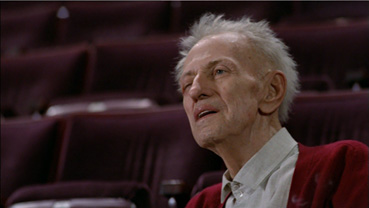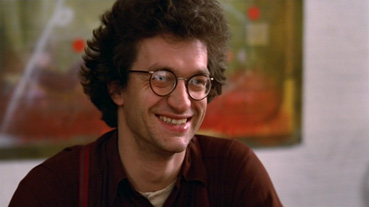| |
"This film is about...a man who wants to bring himself all together before he dies...a regaining of self-esteem. A once very highly successful man." |
| |
Nicholas
Ray |
By
the time he had cast him as the enigmatic painter Derwatt in
his 1977 thriller The American Friend,
Wim Wenders had for many years been a huge fan of the American
director Nicholas Ray, the man responsible for such films
as In a Lonely Place (1950), The
Lusty Men (1952), The
Savage Innocents (1960), the cult favourite Johnny
Guitar (1954), and, of course, Rebel
Without a Cause (1955). During the course of making
The American Friend, these two filmmakers
from different generations and continents became close friends.
Three years later, Wenders visited Ray at his New York home
so that they could make a final film together, one that turned out to be about their friendship and, more specifically,
about the ailing Ray, who was by now in the advanced stages
of terminal lung cancer.
Although
logic would dictate a straight documentary approach, Wenders
and Ray opted for a more formally cinematic interpretation,
shooting on 35mm and staging meetings and conversations
for the camera, as if playing out their own lives as movie
characters in an intimate drama of friendship, art, family
and loss. This approach is intriguingly usurped by the incorporation
of low band video footage of the process of its own creation, shots that announce their presence
with a blast of static and whose grainy fuzziness contrasts
markedly with the polished film look of the main feature.
As the film unfolds, the already fragile line between the staged
elements and the reality behind them begins to crumble,
as Ray's health deteriorates and the storyline, such as
it is, is forced to go where circumstances lead it.

It
shouldn't work. In fact, it should feel awkward and pretentious
and should damagingly distance us from its subject. Certainly
it feels a little odd at first, stranding us strangely between
fact and fiction, but as the film progresses this approach
feels completely and uniquely appropriate, the only logical
way to capture the final days of a man whose life has been, and even at this late stage is still being, lived through
film. What in other hands might be open to charges of exploitation
and insensitivity is here an act of kinship, a therapeutic
bonding between filmmakers through their chosen and beloved
medium of artistic expression. Indeed, from the start it
is Wenders who has reservations about the project, at the
prospect of dealing with Ray's imminent death on film, something
Ray himself assures his younger friend will not be a problem.
But
of course it is. How could it not be? Wenders' reticence
is still visible and is doubled for an audience
that may feel uncomfortable at being this close to someone
going through what for most would be a very private suffering.
At one point Wenders watches his own footage and remarks
that "the camera showed clearly that his time was running
out," but adds that this was not visible to the naked
eye. Perhaps not, and certainly not with the beautifying
effect of 35mm film, but the video camera tells a very different
story, its crude directness burrowing beneath the sheen provided by film, and
beyond the carefully framed and lit image of how Wenders
wants to see his friend to expose with brutal frankness
a seriously ill man who is not long for this world. The
contrast between the two images is sometimes striking, as
when Ray is filmed directing a rehearsal of Kafka's A
Report to the Academy in an otherwise empty theatre
and is framed almost heroically by Wenders' low-angle film
camera, a stark contrast to the sobering video footage taken
of him in hospital just a few weeks earlier.
Reality
finally conquers the film image in a staged but touchingly
honest conversation between Ray and his daughter on what
looks for all the world like his death bed, and a final,
heart-rending close-up in which he appears to be crumbling
before our very eyes, his own, final call of "Cut!"
coming almost as a welcome release. Only the seemingly bolted-on
epilogue of Wenders and his crew drinking to Ray's memory
aboard the Chinese Junk that Ray earlier envisioned as a
suitable end for the film feels out of place, an unfocussed
attempt to provide an upbeat ending for what is otherwise
a bold and remarkably moving epitaph, a final, heartfelt
gift from one artist to another.

The
version here is essentially a director's cut of the film,
reworked by Wenders some time after the event. So depressed
was he at Ray's death, which occurred shortly after filming
had completed, that he handed the material over to his friend
and regular editor Peter Przygodda, who worked for a year
to produce the 116 minute edit that was screened at Cannes.
Word has it that Wenders disliked what he saw and spent
three months working with producer Chris Sievernich to re-edit
the film into its present form. I've not seen the original
cut, which has its staunch supporters, and it would have
been nice to see both side-by-side, but I'm guessing that
Wenders' direct involvement in the US release of this DVD
set would effectively have squashed any plans to do so.
Framed
1.77:1 and anamorphically enhanced, this is another fine
transfer in a box set that is full of them. The analogue
video images inevitably look a little rough, but provide
a very effective contrast to the handsomely reproduced 35mm
footage, whose colour, contrast and detail are first rate.
Some sources have the original aspect ratio listed as 1.66:1,
so it is possible there is some minor cropping here.
As
with other films in the set, we have a choice of Dolby 2.0
mono and 5.1 surround, and as with most of the other discs
there is previous little difference between them. Both are
clear and clean of noise, and that's what counts.
None.
Here we really lose out of the version in the American Wim
Wenders Collection, Volume 2 release, also by Anchor Bay.
That disc includes a Wenders commentary, a featurette entitled
Nicholas Ray: Especially for Pierre and a 38 minute
lecture by Ray. If you are a big fan of this film, the lack
of extras here could be the deciding factor in which box
set to buy.
A
welcome inclusion that certainly has its detractors, but
a film that I found both moving and sincere, a unique approach
to a difficult subject that comes as much from the heart
as from the head. The lack of extras here smarts a bit,
and I for one would welcome the chance to compare this cut
with the one first prepared by Peter Przygodda, but it is
clearly not to be.
|